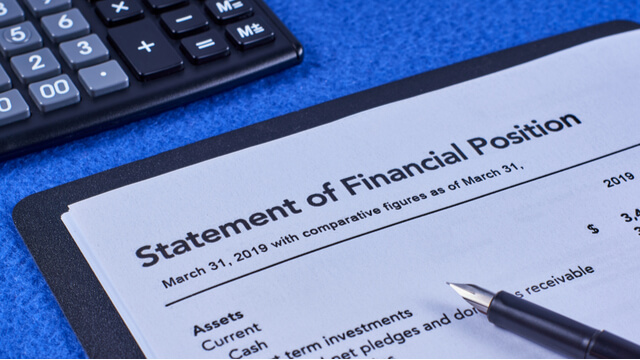Calculating your net worth: statement of financial position

Your net worth is an extremely important figure when it comes to calculating your financial health and planning for retirement. It is also often used to demonstrate your credit worthiness (that is how likely you are to be able to pay off a loan or line of credit) to lending institutions.
In simple terms, your net worth is the sum of all your assets (what you own) less the sum of all your liabilities (what you owe). What is considered to be a ‘healthy’ net worth is different for everyone and really depends on your:
- Personal goals and aspirations
- Age and marital status
- Family status
- Geographic location
- Employment
- Retirement plans
In order to better understand your net worth, it’s important to know what the driving factors are behind your net calculation. One of the ways this is done is by completing a statement of financial position. You might encounter these when applying for a loan, declaring financial hardship or working with a financial adviser as they provide a quick insight to your financial position. You may encounter these statements presented in different ways (i.e. included in the formal loan application or a ‘fact find’ form from an adviser), or choose to create your own.
What is a statement of financial position?
A statement of financial position is essentially your financial world summarised on a page. It will take stock of all income, expenses, assets and liabilities (along with the financial commitments to those liabilities). Here is a template to give you a starting point in calculating your net worth.
When completing a statement of financial position there are a few really important numbers that we will go through. Firstly, it is important to get your income and expense figures correct. The easiest way to get accurate income and expense data is to download a minimum of three months of transaction history from your internet banking. If you use multiple bank accounts, you need to run through the history for each to ensure you’ve captured all of your data. Once you have the raw data you can sort and calculate the income then categorise expenses into the following subcategories:
- Education
- Financial costs such as insurance premiums, accounting fees, financial advice fees and bank fees
- Food
- Health and wellbeing
- Loan repayments and housing costs
- Transport
- Utilities
- Lifestyle spending

The category of expenses is quite important as some are deemed discretionary and others non-discretionary (non-essential and essential). If adjustments need to be made to your budget in order to balance it, the first place to look is often your lifestyle spending as these expenses are usually non-essential whereas expenses such as food and transport can be reduced but generally not by as much. These initial calculations will give you your budget surplus or deficit before any debt outgoings such as loan repayments or lease commitments.
What assets should I include?
The next step is to review your asset position, which means looking at all personal belongings that you own. Some common assets are:
- Property
- Home contents
- Superannuation
- Investments (such as share portfolios or bonds)
- Motor vehicles/motor bikes
- Boats/caravans
- Business goodwill (if you are a business owner)
If you have any personal assets of substantial value, they also should be listed separately from contents. An easy way to determine this is if you’ve listed it on your insurance polies as a specified item, it should also be listed here separately. Common examples of these include jewellery and collectables.
What liabilities should I include?
Liabilities – debts that you owe – require more detailed information so you can forecast the life expectancy and commitment involved. When recording your liabilities, it’s important to know the:
- Credit provider
- Balance of debt remaining
- Limit of the debt (such as the limit on a credit card)
- Interest rate
- Term remaining on the loan/if it’s a line of credit
- Repayment amount and frequency
Modern forms of credit such as Afterpay and Zip Pay should be included as well.
What will my statement of financial position show me?
Once you’ve input all of your personal data into a statement of position, you’ll ultimately get two key numbers.

The first is your net worth, which can be calculated by subtracting the value of your liabilities from the value of your assets. The second is your budget surplus or deficit, which can be calculated by subtracting your expenses from your income.
Once you have your statement of financial position compiled, some assumptions can be made, and often financial institutions will infer your credit worthiness off the back of it. Some examples include:
- If you have high credit card balances or gone over your limit on your credit card, it may mean a lack of ability to manage financial commitments and/or living beyond your means.
- High dependency on one source of income can be seen as a greater risk in the event that income stream should stop (through loss of employment, inability to work etc.) if there is no secondary plan or insurance in place.
- Additional repayments on debt or to savings when there is a greater monthly cashflow can be seen positively as sound and responsible money management.
- Credit cards paid off each month, or with repayments above the minimum commitment, can show ability to manage unsecured debt.
When it comes to determining your financial health from the perspective of a lender, as well as whether your financial situation is sustainable for you personally, as an absolute minimum you don’t (usually) want to be insolvent (where your liabilities are higher than your assets), but there are situations out of your control that may have caused this to happen.
How to improve your credit score
How can I improve my net worth?
Improving your net worth can be done by increasing your assets or decreasing your liabilities. While there are number of ways to decrease your expenses and grow your assets (which you may choose to seek accredited advice for assistance with), often the area where you may be able to make the biggest impact is in controlling your discretionary expenses and reducing your debt levels.
If you are looking at making inroads to improving your net worth, it can be a good idea to:
- Complete a self-audit of your current income and expenses and put them into a budget.
- Map out your short, medium and long-term goals ordered by importance (i.e. paying off credit card debt, saving for a home, owning your own home outright in 10 years).
- Understand what’s required in order to meet your goals (i.e. how much more do I need to save/allocate in order to get there).
- Make adjustments to your budget by reducing discretionary or unneeded expenses.
- Have a system to keep yourself accountable (i.e. tracking your budget each month to ensure you stay on track).
Questions to ask yourself while you complete this are:
- What are my short, medium and long-term goals, and is the way I’m spending/saving/investing helping me get there?
- Are my existing commitments being managed and are my debts being paid down or have a strategy attached to them?
- Do I have a safety net in the event I’m unable to work, lose income or need to outlay an unexpected small sum of cash?
- Do I know how much I’ll need in retirement, and if so, what does that figure look like?
Whether your net worth is high or low, the most important thing you can do is ensure you’re taking steps to help it start or continue trending upwards. It’s never too late to start.
 About Bret Mullavey
About Bret Mullavey
Bret Mullavey is a money and mortgage coach at Experience Wealth, a firm specialising in budgeting and cashflow coaching.
Main image source: Rido Shutterstock






